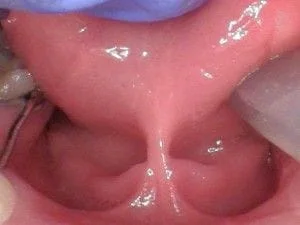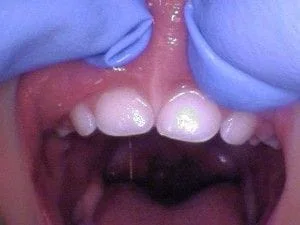Frenectomy Aftercare Instructions
What is a Frenectomy?
A frenotomy of frenectomy is a procedure that consists of releasing the frenum under the tongue or upper lip to allow for better range of motion. Children may be born with a combination of conditions called a tongue-tie (ankyloglossia) and/or a lip-tie causing restrictions in movement that can cause difficulty with breastfeeding, and in some instances, other health problems like dental decay or spacing, speech and airway difficulties, and digestive issues. These issues can generally be corrected by a simple procedure.
Frenectomy – How Does It Work?
A soft tissue frenectomy does NOT cut, it is more a “vaporization” of tissue that occurs with light energy. There is very little discomfort with the proceedure. Some babies and children sleep through the procedure. There is almost no bleeding from the procedure. It sterilizes upon touch therefore has less risk of infection. The healing is very quickand stimulates healing. The result is beautiful tissue, less chance of relapse.

Tongue-Tie – What Does It Really Mean?
Ankyloglossia, or tongue-tie, is the restriction of tongue movement as a result of fusion or adherence of the tongue to the floor of the mouth. A tongue-tie is therefore caused by a frenum that is abnormally short or attached too close to the tip of the tongue.
Normal tongue function is important for multiple reasons. Among the many benefits, normal tongue function will allow a baby to latch adequately and breastfeed efficiently, promote normal speech development, make it possible for a child to self-cleanse the mouth during eating, allow adequate swallowing patterns, allow for proper growth and development, and it makes fun little things like eating ice cream, kissing or sticking your tongue out to catch snowflakes possible.
Challenges that can occur with a tongue-tie:
- Inability to open mouth widely affects speech and eating habits
- Inability to speak clearly when talking fast/loud/soft
- Clicking jaws
- Pain in jaws
- Protrusion of the lower jaws, inferior prognathism
- Effects on social situations, kissing, licking ice cream
- Dental health- a tendency to have inflamed gums, and increased need for periodontal surgery
- Tongue tie in the elderly often makes it difficult to keep a denture in place

How Can A Lip-Tie Affect My Child?
A lip-tie occurs when the upper lip remains attached to the upper gum. Challenges that can occur in children and infants with moderate to severe lip-ties:
- Spacing between the maxillary central incisors, a large gap can form called a diastema
- Difficulties with brushing and flossing
- Increased risk of dental decay
- Repeated trauma to the maxillary frenum because it is so low and prominent
- Pain with breastfeeding
- Inability to adequately flange the maxillary lip upward during breastfeeding, affecting an infant’s latch and ability to create a good seal
Why Does It Hurt When I Breastfeed My Baby?
Many mothers are often told, or mistakenly assume, that if they cannot successfully breastfeed, there is something wrong with them. In fact, this is not true. Infants may be born with a combination of limiting conditions called a tongue-tie (ankyloglossia) and/or a lip-tie.
Tongue-ties are normally straight forward to diagnose and fairly easy to treat: the tongue is heart shaped when the baby cries; there is an obviously tight frenulum underneath that runs from the floor of the mouth to an area close to the tip of the tongue. Tongue-ties can vary in severity and can include what we call “posterior tongue-tie” which is a lot more difficult to diagnose and recognize. The frenulum looks like it is non-existent so the first instinct is to believe that tongue-tie cannot be the issue. The tongue looks squared off with the floor of the mouth webbing/tenting the tongue. The edges of the tongue will form a cup when crying as it is unable to elevate. The tongue cannot move side to side but instead twists side to side. The tongue struggles to extend out of the mouth while it’s open but is absolutely incapable of “sticking out” when wide open, which is the ideal position for breastfeeding.
Mothers who try to breastfeed their tongue-tied baby suffer tremendously, both mentally and physically. Not only does she have to re-latch the baby multiple times during a feed and deal with feedings that last sometimes hours, she also experiences damaged nipples, cracks, bruises, and pain during feeds. Her risks of breast infection increases and her milk supply can be greatly reduced due to the lack of stimulation from an inefficient latch.
The babies may be losing weight, get sleepy during feeds (as they work much harder than other babies to stay latched), and become extremely gassy and irritable making the parent’s experience even more frustrating. Lip-tied babies end up with blisters on their lips from trying so hard to stay latched. Babies tend to feed a lot more often because their inefficiency results in less intake of milk so hunger kicks in faster.
Why Have The Tongue-Tie And/Or Lip-Ties Released For My Baby?
- To help make breastfeeding more successful
- To help relieve the pain of breastfeeding and regain healthy nipples and breasts
- To stimulate milk production by adequate stimulation
- To help achieve satisfactory bonding between a mother and her baby
- To ensure adequate feeding and growth of the baby
- To avoid serious long term issues with palatal development, tooth spacing, dental caries, speech impairments, social stigma
What Can I Expect After The Frenectomy Is Done?
Breastfeeding immediately after the procedure is fine as breast milk contains amazing healing properties and the simple act of breastfeeding will reassure and soothe the baby.
It is possible that latching will be a struggle at first since we are using a small amount of anesthetic to complete the procedure. The numbness will wear off about 30-45 minutes after the procedure. Do not be alarmed if latching is difficult at first.
Posterior tongue-ties may require a few weeks of practice before seeing the benefits of the frenectomy. We recommend to be thorough with the prescribed post treatment exercises and to work with the lactation consultant and possibly a bodyworker (cranial sacral therapist, pediatric chiropractor, etc.) to increase the chances of success.
